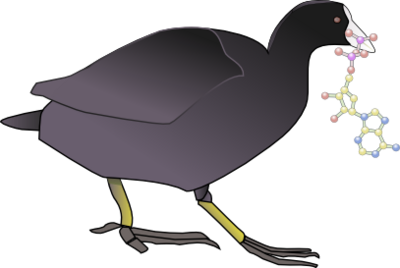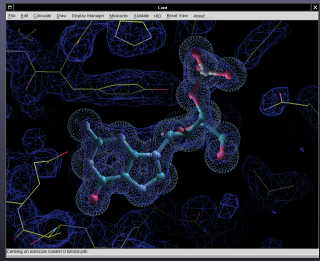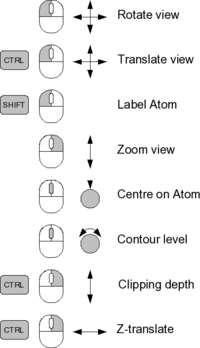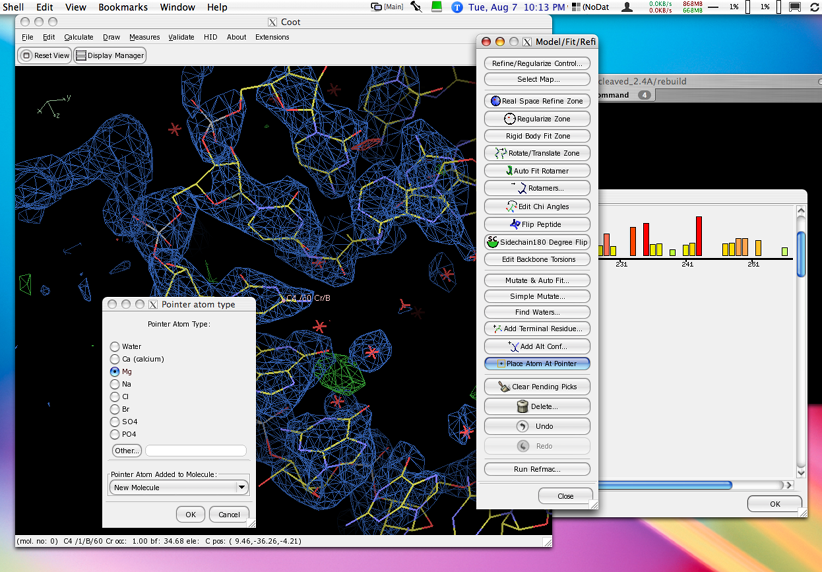Coot: Difference between revisions
Kevin Cowtan (talk | contribs) |
Bernhardcl (talk | contribs) |
||
| Line 61: | Line 61: | ||
====[http://www.ysbl.york.ac.uk/~emsley/coot/mbox-2004-2005/ Mailing list archives: 2004-05]==== | ====[http://www.ysbl.york.ac.uk/~emsley/coot/mbox-2004-2005/ Mailing list archives: 2004-05]==== | ||
==Scripts== | ==Scheme Scripts== | ||
Coot can be scripted in scheme (guile) or python - support for each is more or less equal these days. | Coot can be scripted in scheme (guile) or python - support for each is more or less equal these days. | ||
| Line 197: | Line 197: | ||
[http://xanana.ucsc.edu/xtal/osx_xtal_applets.dmg.gz Download the Applet] (requires a separate working coot installation) | [http://xanana.ucsc.edu/xtal/osx_xtal_applets.dmg.gz Download the Applet] (requires a separate working coot installation) | ||
==Python Scripts== | |||
===Example 1: Bernhard Lohkamp's Key Bindings=== | |||
Just so you get an idea of the customization by key bindings here are what Bernhard/Paul uses currently (add to your .coot file or put the file in .coot-preferences directory). | |||
[[bernhards_key_bindings_for_coot.py]] | |||
=Enhanced Menu Appearance= | =Enhanced Menu Appearance= | ||
Revision as of 14:39, 10 September 2008

Installing Coot
Installing Coot on OS X
Please refer to the Installing Coot on OS X page
Installing Coot on Linux
Installing coot on linux is rather more straightforward than on OS X, because most linux systems are based on gnome and/or kde, and tend to have many of the required components already installed. Most of the other dependencies are also readily available.
Installation from a binary package
This is the recommended way for those who do not want to delve into the mysteries of compiling and linking a great but complex piece of software. Read the (somewhat outdated, it seems) Coot FAQ to find "Additional Notes" for your operating system.
In short, just go to http://www.ysbl.york.ac.uk/~emsley/software/binaries/nightlies/pre-release/ and pick a suitable binary, e.g. coot-0.5-pre-1-revision-1003-binary-Linux-i386-fedora-5.tar.gz for a Red Hat Enterprise Linux 5 or CentOS-5 system (Fedora 6 corresponds to RHEL5, thus Fedora 5 binaries are OK). If you prefer a "stable" binary, these are at http://www.ysbl.york.ac.uk/~emsley/software/binaries/stable/.
Then un-tar it under /usr/local/src (or in your $HOME), and establish a symlink (ln -s) between /usr/local/bin/coot and the bin/coot of the freshly unpacked distribution.
If you then run coot, and the loader complains that a certain library is missing, just ask
yum whatprovides <thatlibrary>
and install the library, again using yum (assuming yum is available in your distribution, otherwise use apt or whatever is there for this purpose).
Installation from source code
Installation of coot and all of its dependencies are handled automatically through the autobuild scripts. There are two versions:
- GTK1 - the old user interface. This script builds coot and all its dependencies.
- GTK2 - the new user interface. This script builds coot and most of the dependencies, excluding GTK2.
To build Coot, all you should need to do is edit a few settings in the top of the build script, or alternatively specify those settings as environment variables. For example, the following sequence of instructions will build the latest pre-release of the GTK 2 version with python support:
wget http://www.ysbl.york.ac.uk/~emsley/build-logs/build-it-gtk2-simple export AUTOBUILD_INSTALLED=${HOME}/autobuild/coot export AUTOBUILD_BUILD=${HOME}/autobuild/ export LOGS=$AUTOBUILD_BUILD/logs export NIGHTLY_DEST_DIR=$AUTOBUILD_BUILD export STABLE_DEST_DIR=$AUTOBUILD_BUILD export build_coot_prerelease=1 bash build-it-gtk2-simple python > build.log
(This script works in bash. For tcsh, replace 'export' with 'setenv' and '=' with ' '.
In some cases you may need to download additional development packages in order to build all the components.
There are also instructions for Custom building Coot from source code. This should not be attempted except by experts.
Running Coot
General Topics
Controls
External Links
On-line User Manual
Coot's home page
Mailing list archives: (no longer) current
Mailing list archives: 2004-05
Scheme Scripts
Coot can be scripted in scheme (guile) or python - support for each is more or less equal these days.
Several examples of coot extensions to the language can be seen by examining the 0-coot-state.scm file that coot leaves behind when it finishes.
COOPS
Coops generates a coot script from the output of molprobity, specifically probe, reduce, cluster and clashlist.
For an explanation of the principals underlying reduce and clashlist see the Dots Page. Get Molprobity software here.
Use Coot version 0.1 or higher.
Invoke like this (from the directory in which you run coot):
$ coops myfile.pdb
The use Calculate->Scripting to read in and run coops.scm
Get COOPS here.
Example Scheme Script 1: Move to Molecule Centres
This example can be found in the coot scheme sources (the function name is molecule-centres-gui and is in the xxx/share/coot/scheme/coot-gui.scm file). It is a simple function that creates a button box - a button for each coordinates molecule in Coot. It is annotated. Reproduced as coot-scheme1.
Example Scheme Script 2: Demo a Few of Coot's Features
Reading in a pdb file, an MTZ file and manipulating the model
This is a composite script and demonstrate reading pdb file, an MTZ file, translations, zoom, spin zooms, contour level changing, map masking, real space refinement, water addition and loop fitting.
The data files used in the example can be obtained here and here. Put them in the directory where you start coot. Save the script to your disk, then use Calculate -> Run Script... to activate it.
Example Scheme Script 3: Read CNS data
This CNS data reading script is a Cootenization of the CN2COOT script written by Joel Bard (it is based on his csh script) and can be used to compare and contrast scheme programming and shell script programming (the coot version is longer to some extent because it does extra error checking).
As well as doing the conversion the resulting mtz/maps are loaded into Coot.
It is part of Coot as of version 0.1.2.
Example Scheme Script 4: Load the Latest Data and PDB files Automatically
To load the most recent files, do this:
coot --script latest-files.scm
which enables the scripting function: (load-latest-files)
For extra gui goodness (you will need 0.1.2):
coot --script latest-files.scm --script extensions.scm
Example Scheme Script 5: Saving a Partial model
Here we create a small function to save part of a molecule and add a gui interface, it can be used in the usual way (i.e. with --script on the command line, Calculate->Run Script... or add the script to your ~/.coot file.
save-partial.scm
Example Scheme Script 6: Creating an interface for the Powermate Dial
The Powermate dial can be used with coot. One could just assign the rotations to +/-y keys and be done with it, but this script gives you a way of having positive and negative rotations in all three cartesian directions. The F1 key is mapped to positive rotation, the F2 key to negative rotation, and the F3 key permits you to toggle through x, y, and z, on successive key presses. I then map F1 and F2 into the ordinary rotations on the powermate (using send key equivalents) and then I map F3 into the single click on the dial, making it easy to toggle through x, y and z. The press-and-rotate options remain available; I map these into scroll up and down, and put them on the slowest response setting, which makes contouring density easier to control than it is from my mouse scroll wheel.
powermate-coot.scm
Example Scheme Script 7: Applying arbitrary value to "B" factor column
Imagine you have a file of some property (Chemical Shifts, for example) of a residue that you wish to apply to the atoms of a particular model from a pdb file as pseudo B factors. Here's how to do that in Coot:
We have a file "cs.tab" like this, the residue number then the chemical shift value (one for each residue in a particular chain):
1 1.53159
2 4.35884
3 4.07123
4 4.16932
5 6.69103
6 7.12071
7 10.7419
8 9.57176
Use apply-cs.scm to apply these values as pseudo temperature factors. Typical usage, where "A" is the chain id, and cs.tab the file of values per residue.
(apply-cs (read-pdb "test.pdb") "A" "cs.tab")
--script apply-cs.scm
Example Script 8: Partial Occupancy Dialog
Imagine that you have a structure that has residues with partial occupancy. After refinement, it would be convenient to quickly navigate to all such residues. How can that be done?
Start coot with command line arguments:
--script partial-occupancy-navigation.scm
This will provide an extra menu item called "Extras", clicking on "Residues with low occupancy..." therein will lead you through the process. Note that this will often work with SHELXL molecules, because they have atoms with negative (e.g -31) occupancies.
Note also that you will need a recent version of Coot to use this, as it stands. This will not work on stock Coot version 0.4.x. You can enable this for use with 0.4.x if you update/replace your xxx/share/coot/scheme/coot-gui.scm file from here.
Example Script 9: A GUI for Chopping Back Sidechains from a Residue Range
This is a simple interface to the delete-sidechain-range function, it illustrates how arguments can be transfered from the GUI to the scripting function. It was written in response to a question from Byron DeLaBarre.
Unfortunately (prior to 0.5) there was an error in the standard delete-sidechain-range function, which is why we over-ride it.
--script chop-side-chains-gui.scm
Example 10: How do I bind a key to Toggle the display of NCS ghosts?
With this script: toggle-ncs-ghosts-script
Example 11: Paul Emsley's Key Bindings
Just so you get an idea of the customization by key bindings here are what Paul uses currently (add to your .coot file).
Optional Wrappers and (External) Shell Script Enhancements
I (wgscott) wrote a coot wrapper shell script that lets you convert xplor/cns maps on the fly (you need to install mapman first) and has a few other enhancements.
I also made a Coot OS X applet that allows you to drag and drop a cns/xplor or ccp4 mapfile or any other coot-compatable file (mtz or pdb file, for example). Using the File > Get Info dialog, you can program this applet to open all .map and all .mtz files, if you want to, making these files double-clickable.
Download the Applet (requires a separate working coot installation)
Python Scripts
Example 1: Bernhard Lohkamp's Key Bindings
Just so you get an idea of the customization by key bindings here are what Bernhard/Paul uses currently (add to your .coot file or put the file in .coot-preferences directory).
bernhards_key_bindings_for_coot.py
Enhanced Menu Appearance
As of 0.4, coot works with gtk+2
This permits use of themes for a more OSX-like experience, among other things.
Click on the thumbnail image below to see a full-size screenshot of Coot with a gtk+2 Aqua-like theme.
To get this effect, you need the Glossy_P gtk+2 theme:
http://art.gnome.org/download/themes/gtk2/571/GTK2-Glossy_P.tar.gz
Edit a file called ~/.gtkrc-2.0 and put into it the following line:
include "/usr/share/themes/Glossy_P/gtk-2.0/gtkrc"


